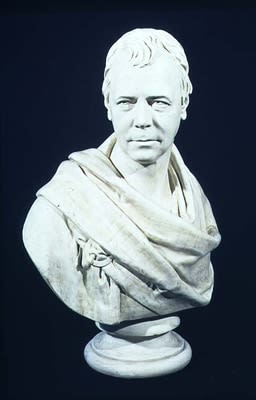
After Sir Francis Chantrey RA
To view all current artworks for sale visit philipmould.com
Chantrey's bust of Walter Scott was considered to be the best contemporary likeness of the writer, perhaps owing to an unusual circumstance in its creation. The sculptor was dissatisfied with the conventional aspect of the original pose, and so sliced the head of his finished clay model to reposition in the present more animated manner. The result is immediately apparent, and the characterisation benefits from a sense of engagement with the viewer, as though Scott were 'about to break into some sly, funny old story.'
The sittings were appropriately social occasions, which always included breakfast and companions that the sculptor insisted should be good talkers. Uniquely the sittings for this bust were requested by the sculptor rather than the subject, and on completion Chantrey presented Scott with the marble as a token of his respect and friendship. It is worth remembering in this context, that in addition to his fame as a novelist, Scott enjoyed a now-forgotten reputation as Scotland's premier social host in the nineteenth century
Understandably given the intimate nature of the commission, the form of the sculpture is wittier and more adventurous than that employed for Chantrey's more worldly patrons. Here the classical toga that had been a feature of the sculptural portrait since the renaissance is given a new twist by being represented in carved plaid, with a Highland brooch to fasten it.
A plaster cast was exhibited at the Royal Academy in 1821, and the marble was completed in the following year. This remains at Abbotsford, and is the model for a number of plaster and marble copies. These latter, such as the present bust, were produced under Chantrey's direction by assistants such as Henry Weekes. The present version can be distinguished from many of the repetitions by the quality of the carving and by, for example, the incision of the pupils and irises, which are blank in some versions, such as those in the later autograph repetition in the collection of the National Portrait Gallery.
Provenance
The Collection of a Private CorporationBe the first to hear about our available artworks
* denotes required fields
We will process the personal data you have supplied in accordance with our privacy policy (available on request). You can unsubscribe or change your preferences at any time by clicking the link in our emails.